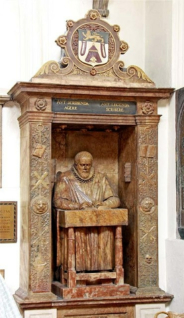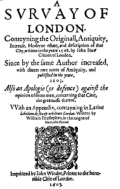





Docklands and the Thames,
Victoria Park to Paternoster
Square. Take a nostalgic
trip back to the East End in
the 1950’s or a stroll around
the Square Mile of the City
of London. It’s all here at
barryoneoff.co.uk
JOHN STOW and his survey of London
Copyright 2002 - 2024 ©Barry Carter. All rights reserved
John Stow - Historian
1525 - 1605
"The merry old man". That was the way this extraordinary character was described by many. It is only fair and fitting that he gets a mention here, as he devoted his life to compiling records of the Square Mile that are still used as a reference by many. People hunting for the secrets of a long gone London. He put his life at risk by collecting many documents at a time when religion and politics caused the authorities to suspect any type of odd or eccentric behaviour. He spent almost his entire life and all of his money delving into the history and walking the streets of the City of London. He wrote a great deal on the subject, his most famous work was ‘A Survay of London’, first published in 1598 and a revised edition in 1603. Below is a very brief history of the man who’s lifetime passion was the streets and history of the square mile.A License To Beg
It was only just a year before Stow's death that the king bestowed him with this ‘honour’. Almost his entire life and all of his assets spent gathering information to produce some of the most valuable insights into life in England, especially London, and he was rewarded with a license to beg. I dare say he did get a few sums of money made available to him by some of his patrons during his life, but it still was not a great deal to show for his sacrifices. The Survey of London was his last work, published in 1598 and a revised edition in 1603, the year that ended the Elizabethan era. At the start of the 17th. century as Stow’s work and life were both nearing their end the population of England was around four million. An eighth of these lived in London. 250,000 people may not be a lot by today’s standards but it was massive in the square mile of the time, and Stow gave glimpses of what life was really like. Some humorous, some sad, but all interesting to the hobbyist historian. As well as his Survay of London he had published other works from 1565 onwards under titles such as: The Summarie of Englyshe Chronicles, The Chronicles of England, and The Annales of England. In 1605 he was buried at St. Andrew Undershaft. There is a memorial to him sitting at his desk holding a quill. Every three years the Lord Mayor changes the quill in a ceremony.A Very Brief Biography
John Stow was born in Saint Michael's parish, Cornhill when Henry VIII was on the throne. He also lived through the reigns of Edward VI, Elizabeth I and part of James I. It is believed that he spent his childhood living in what is now Throgmorton Street somewhere near the site of the old Stock Exchange building near Threadneedle Street. His father was a tallow chandler but Stow decided to become a merchant taylor. After completing his apprenticeship in 1549 he worked until he was about forty, doing his research on London in his spare time. He then decided to give up the tailoring business and concentrate on his historical projects full time. He had been spending all his spare time engrossed in his information gathering, and at 36 he started publishing his other works. From the time he gave up tailoring all his money was used to finance his research and writings. It was sometimes extremely dangerous, as being a catholic put him in a precarious position when suspicions were raised about his wanderings and his collections of ancient documents I have used his work for research on this web- site at times, mainly for geographical reasons. On occasion I have had to make a guess at certain place names from the old English he used, but in the main they are straightforward. One instance of this as an example would be what he calls the Grass Church, called so because it was near the grass market. This leads us to find that the street where the Grass Church stood was known as Grass church street, which was corrupted over the years to the Gracechurch Street we know today. It is amazing how the names get changed over the years.



















